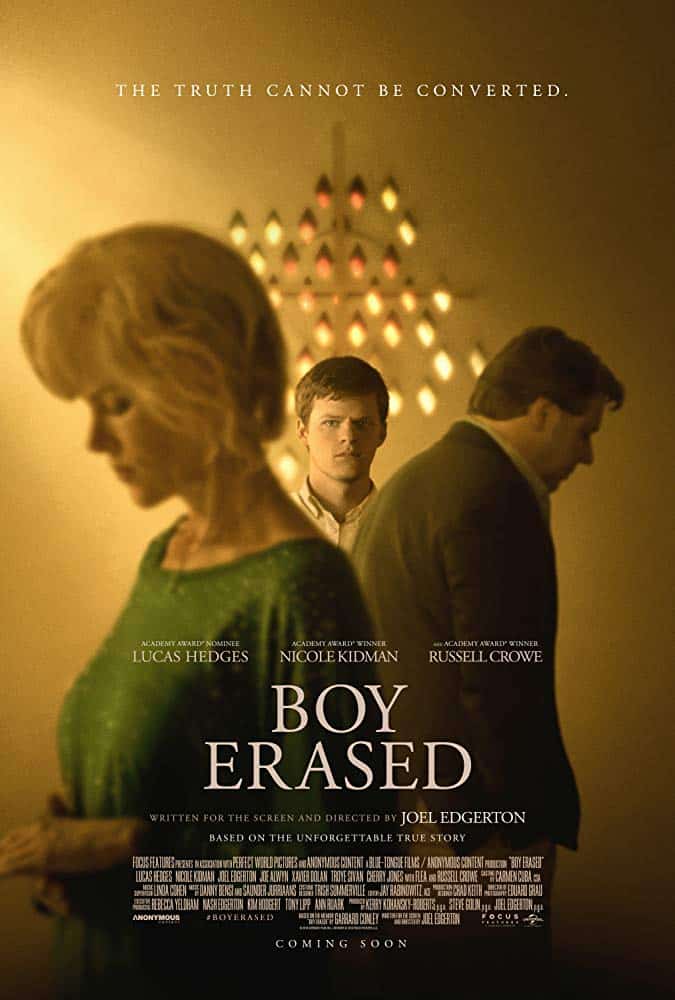[Note: This review includes spoilers.]
Boy Erased is a film based on the true story of Garrard Conley, as told in his autobiographical book by the same name. In the movie, Conley is portrayed as “Jared” by the brilliant Lucas Hedges, while his mother and father are played by the equally gifted Nicole Kidman and Russell Crowe.
Jared is a 19-year-old teenage son of a preacher from Arkansas. Early in the movie, he is painfully outed as gay to his parents by another student who had raped him at college. Jared is too ashamed to admit to his parents that he was raped, but feels forced to tell his parents he is gay.
“I…think about men. I don’t know why, and I am so sorry,” Jared says to his parents, whose eyes well with tears of fear and pain. This leads to him being sent to a two week gay conversion therapy program called “Love in Action.”
The conversion therapy includes making a family tree of “hereditary” sins (addiction, homosexuality, mental illness, etc.), learning to “stand like a man,” and a communal confession of past sexual sins recorded on a Handycam.
In the climactic scene, Jared breaks down and calls his mother to come take him away from “Love in Action”. She picks him up, and despite his father’s protests, they drive away and never turn back.
I left the theater stunned after viewing this movie. Stunned because of the brutality of what happened, and because this is merely one out of thousands of similar stories. I was enraged by the tragedy of how Christianity could be warped to such an extent that people would be harmed in this way.
But the most troubling question that rose in my mind was whether it was possible that Catholic Church teaching or pastoral practice with LGBTQ people had contributed to the kind of violence depicted in Jared’s story.
I knew I could not brush this question aside by merely affirming that I personally found conversion therapy abhorrent, or by making some sort of abstract argument. I needed to know whether the actual practice and concrete history of my faith tradition contributed to this kind of violence. So I began digging and here’s what I found:
- In 1973 the American Psychological Association declassified homosexuality as a mental illness. In 1980, Fr. John Harvey became the founding director of Courage as a ministry to people “experiencing same-sex attractions (SSA).” The purpose of Courage has been to help people with SSA live a chaste life according to the teaching of the Church. Into the 1990’s, Courage literature affirmed, “for those who really want it, reparative [conversion] therapy is a possibility and happens regularly.”
- In a 2001, an article originally penned by Harvey and reprinted with his and Courage’s permission reiterated this point, stating, “For those who really want it, reparative growth is a possibility and happens regularly. Men and women leave behind not only the homosexual lifestyle but also the very feelings of same-sex attraction. While all can investigate this option, teens and young adults are especially invited to consult competent therapists.”
- After founding Courage, Fr. Harvey published several popular books that among other things condoned conversion or “reparative” therapy for homosexual individuals. In 1994, Courage had grown to the point of gaining support from the Holy See. Harvey eventually stepped down as director of the organization in 2008. The organization has since stated that it does not support conversion therapy, though there remain unsettling connections. Today it is one of the largest ministries to LGBTQ Catholics in the U.S.
- Dr. Joseph Nicolosi, a Catholic psychologist, was the co-founder and president of the National Association for Research and Therapy of Homosexuality which began in 1992 (NARTH).1 This organization promoted research concerning conversion therapy treatment for homosexual persons. In 2010, the Society of Catholic Social Scientists awarded Nicolosi the “Blessed Frederic Ozanam Award” for Catholic Social Action. Two Cardinals, seven archbishops, and eight bishops sit on the Bishops Board for this organization.
- In 2006, a document from the USCCB titled “Ministry to Persons with a Homosexual Inclination: Guidelines for Pastoral Care” took an ambiguous stance toward conversion therapy.2 In 2016, a spokesperson for the Mexican bishops implied their support of conversion therapy. While U.S. bishops have not specifically affirmed conversion therapy in recent years, I could not find any significant public and collective denouncement of its practice.
- For a contemporary example of how discussion of conversion therapy continues to persist in some Catholic circles, see this video of the Patrick Coffin Show, published in May, 2018 (beginning at 45:10).
In sum, the Catholic Church has had a troubling connection with conversion therapy over the past fifty years. Several of the individuals and organizations above have had powerful influence at least within the American Catholic Church, and probably beyond.
One may still object to the claim that Boy Erased implicates the Catholic Church in the suffering of LGBTQ people in conversion therapy. The film, of course, is not explicitly about a Catholic community. And perhaps the practices that Fr. Harvey, Courage, and NARTH/ATCSI promoted were different and not as extreme as those shown in the film.
Yet even after examining this history and seeing Boy Erased, I sense that there is something deeper and more damaging at the root of all of this that strikes at the very core of LGBTQ people.
It is the belief that their orientation understood as a “disorder” is an evil rot at the core of their hearts. It’s the belief that every element of that part of them; each attraction, each stirring, each thought, is pure poison to the soul. Here I think is the deepest suffering that a story like Boy Erased reveals.
In his book, Conley writes:
“…a constant guilty ache…ran through my body for so long that I came to believe the feeling was just a part of what it meant to be alive….What did it feel like to not have to think about your every move, to not be scrutinized for everything you did, to not have to lie every day?”
Boy Erased is a story of how damaging shame about one’s sexual orientation can be. It shows how even a “philosophical/theological” notion of “disorder” can twist its way through people’s minds and lives to the point that it becomes embodied in individuals, in their families, and even in entire institutions.
I am not here to debate the Church’s moral teaching about homosexuality. And I am optimistic enough to believe that our Church leaders and many Catholics have no malicious intent toward homosexual people when they defend the language of “disorder.”3
But regardless of intention, the truth of the past is that this language and the ideas surrounding homosexuality in the Church have morphed into destructive messages of shame. These messages have lodged themselves deep in the hearts of LGBTQ children, teenagers, and adults and have caused mental illness, family abandonment, physical violence, and even suicide.
In Boy Erased, I see more clearly the meaning of Jesus’ words, “You impose on people burdens hard to carry, but you yourselves do not lift one finger to touch them” (Lk. 11:46).
Yet remarkably, like Christ, many LGBTQ people have not responded with vengeful dismissal of the people who have hurt them. Rather, they respond as Christ did with the words, “Father, forgive them, for they know not what they do.” (Lk. 23:34).
The story of Boy Erased ends with Garrard Conley forgiving his mother, with whom he now has a wonderfully loving relationship. And he continues to dialogue with his father, seeking understanding. Hopefully Boy Erased can both illuminate the pain that so many people have experienced, but also point us toward a path of forgiveness and healing.
- The organization now operates under the name The Alliance for Therapeutic Choice and Scientific Integrity (ATCSI). ↩
- See subtitle “Therapy for Homosexual Inclinations?” ↩
- Note the Catechism of the Catholic Church which states, “They (homosexual persons) must be accepted with respect, compassion, and sensitivity. Every sign of unjust discrimination in their regard should be avoided” (CCC 2358). ↩


